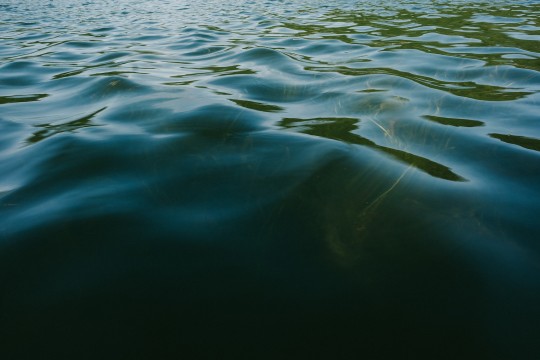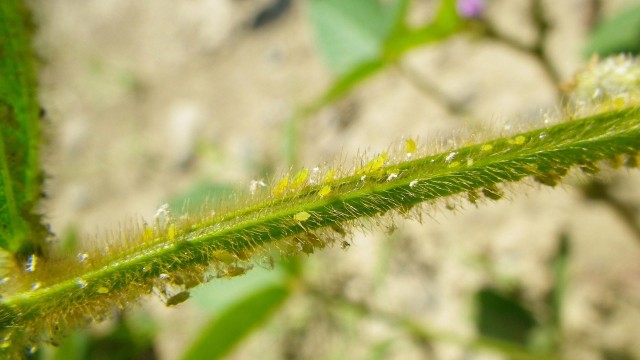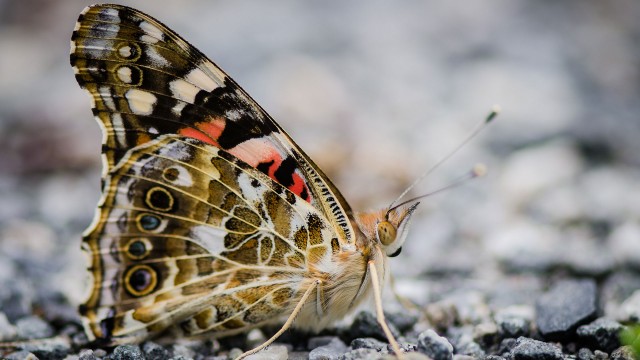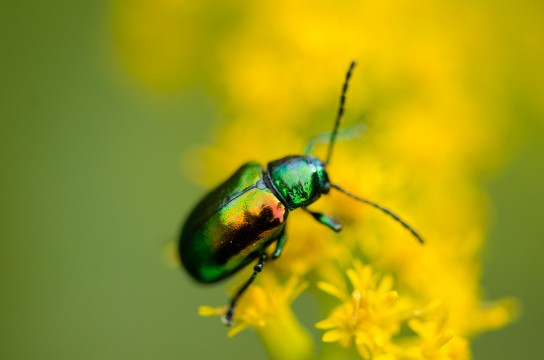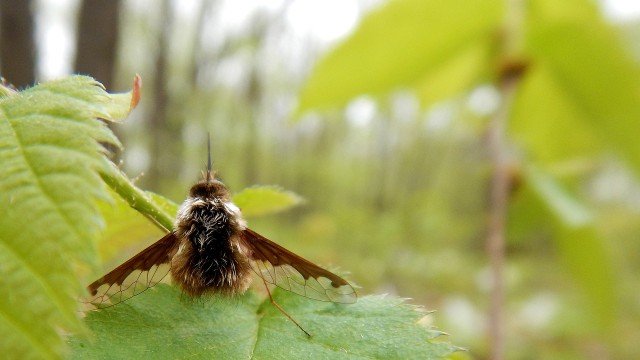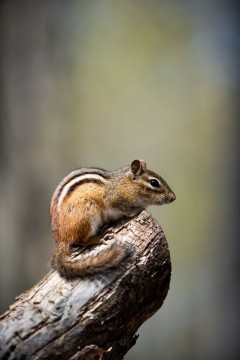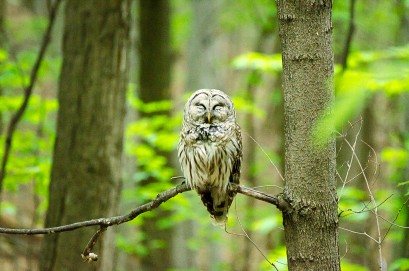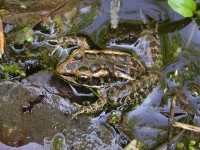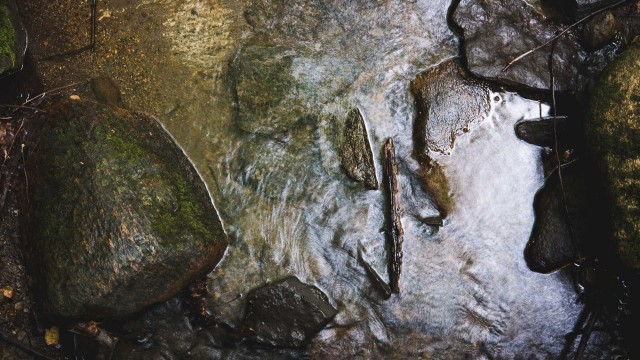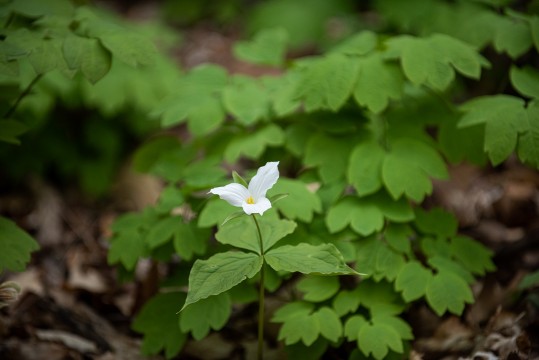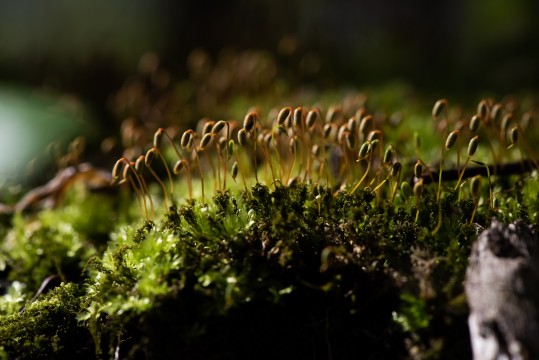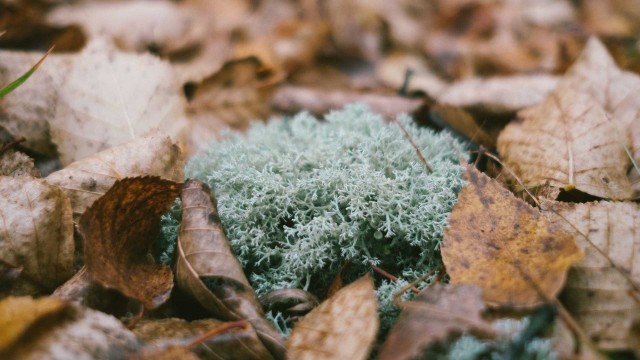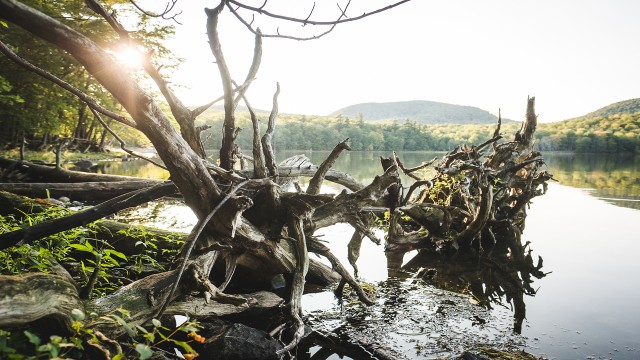Since October 2004, the Ministère du développement durable, de l'environnement et des parcs du Québec has been supporting McGill University's mission to protect for future generations its Mont Saint-Hilaire property by recognizing the Gault Nature Reserve as an official nature reserve under the Natural Heritage Conservation Act.
Aphids
Aphids feed exclusively on the sap of plants. Each species is usually adapted to a single host. A study identified 59 species of aphids on Mont Saint-Hilaire. Some of them are considered rare.
Lepidoptera
Louis Handfield, a resident of Mont-Saint-Hilaire, is an amateur lepidopterist. For nearly 30 years, he has collected various species of butterfly that can be found in Quebec and Canada. His exceptional efforts have helped identify over 800 species of macrolepidoptera in the Mont Saint-Hilaire region. Such wealth is undoubtedly the result of the diversity of habitat and host plants that can be found on the mountain. According to Mr. Handfield, 130 of these species are rare or local.
Coleoptera
Coleopterans represent about 40% of insect species. They occupy every imaginable habitat. These insects possess two pairs of wings. The outermost pair of wings, the elytra, form a hard carapace, protecting the insect and the inner wings used for flight.
A study conducted after the ice storm aimed to investigate the current and future health status of maple stands using xylophagous and saproxylophagous coleopterans as bioindicators. The incidence of such storms can increase these insect populations. 69% of the insects collected were xylophagous (feeding on wood), and only 11% were saproxylophagous (feeding on dead and decomposing plants and animals). A total of 69 insect species were collected in this fairly brief survey, of which 17 were found only in this forest, which has been qualified as diversified from an entomological point of view.
Diptera
Dipterans are one of the largest orders of insects. They can be found everywhere. They are generally small, have a single pair of wings and have mouthparts adapted to the food on which they feed.
Vertebrates
Mammals
The most frequently observed mammals at Mont Saint-Hilaire are chipmunks, squirrels, raccoons and porcupines.
The old-growth forests provide choice habitats for other more reclusive species. Some are mostly active at night, like flying squirrels and bats. Others are more fearful, avoiding human contact like coyotes and white-tailed deer.
Some unexpected visitors made an appearance in 1999. A bobcat, a possibly threatened species in Quebec, and a female moose were seen briefly in the forests of Mont Saint-Hilaire. It is believed that they moved on to larger habitats.
Birds
In spring and fall, Mont Saint-Hilaire welcomes many migratory bird species. Hundreds of ducks, geese and bluebills stop to rest on Lake Hertel. Hundreds of migrating birds of prey also fly over the region during these periods.
More than 200 species of birds have been identified on the mountain. Migratory birds, breeding birds and residents make use of the habitat on Mont Saint-Hilaire.
Probably the most striking bird of prey at Mont Saint-Hilaire is the peregrine falcon (Falco peregrinus). A couple can be seen nesting on the Dieppe Cliffs every year. There are only 10 successful nesting sites in Quebec for this endangered species, and Mont Saint-Hilaire is the best. The species is especially disturbed by human activity near its nesting site, which is why access to the cliffs at Mont Saint-Hilaire is strictly forbidden.
Reptiles and Amphibians
On Mont Saint-Hilaire, there are four species of salamanders, eight species of frogs, two species of snakes and two species of turtle.
Although these species are relatively well protected on the Gault Nature Reserve, these populations are still very fragile. Amphibians are especially sensitive to pollution and loss of habitat. For example, the dusky salamander (Desmognathus fuscus) and the western chorus frog (Pseudacris triseriata) have now disappeared from Mont Saint-Hilaire. Because of their popularity as pets, reptiles and amphibians are also threatened by illegal collection. The popularity of vivariums has weakened these populations. Is it not better and fantastic to observe these animals in their natural habitat?
Fish
Lake Hertel contains only 10 species of fish. They live in shallow waters.
Contrary to popular belief, the lake has an average depth of only 5 metres, and its deepest point is only 9 metres.
Flora
Forest
The Mont Saint-Hilaire forest is situated in a sugar maple-hickory stand in the mildest and most diversified zone in Quebec.
The dominant tree species are sugar maple (Acer saccharum) and American beech (Fagus grandifolia). This forest has not been disturbed much by human activity. It is an old forest. Some of the maples are more than 400 years old. The surface area occupied by the region’s sugar maple-hickory stand has shrunk considerably since colonization. As a result of urban development and agriculture, only 5% of the habitat is still intact. Mont Saint-Hilaire is among the 13 remaining tracts of old-growth forest that are still intact.
Old ecosystems such as this one are extremely rare. It is therefore an important site for biodiversity conservation in this part of North America.
Vascular Plants
The Mont Saint-Hilaire flora is particularly rich and diversified. There are more than 600 species of vascular plants. Several rare and threatened species can be found here. Twenty-one (21) species have been designated as at-risk, and two (2) are endangered.
The species are mostly from the following major families: Asteraceae (11%), Rosaceae (7%), Cyperaceae (7%) and Poaceae (7%). Ferns account for 6% of the vascular plants found on the mountain.
Bryophytes, non-vascular plants (mosses and liverworts)
Bryophytes are the oldest photosynthetic organisms typically found in terrestrial habitats. This group, probably originating from algae, developed structures enabling it to colonize on land. There are three distinct classes of bryophytes: mosses, liverworts and hornworts. At Mont Saint-Hilaire, there are 212 species of moss and 36 species of liverworts.
Lichens
Lichens result from the symbiosis between a fungus and a photosynthetic microorganism (bacterium, alga). The fungus part supports the algae’s growth and, in turn, provides the fungus with carbohydrates from photosynthesis. Precipitation supplies most of their nutritional needs. They can grow on various substrates (rock, bark, leaves, soil, wood). There are nearly 20,000 species of lichens. At Mont Saint-Hilaire, 54 lichen species have been identified, many of them rare.
Lichens are particularly sensitive to air pollution. Therefore, they are very useful bioindicators in monitoring the state of evolution of our environment.
Geology
Contrary to popular opinion and despite its shape, Mont Saint-Hilaire did not originate as a volcano. Instead, it is a pluton that originated as an upwelling of magma that did not reach the Earth’s surface but cooled slowly as a mass of igneous rock surrounded by the rocks it had penetrated. Over millions of years the surrounding softer sedimentary rocks were eroded away by the action of water, weathering and glaciation, leaving the mountain we see today
Mont Saint-Hilaire, like the other nearby mountains (Mont Royal in Montreal, Mont Saint-Bruno, Mont Rougemont, Mont Saint-Grégoire, and Mont Yamaska), is one of the ten Monteregian Hills, a line of plutons that stretch from Oka west of Montreal to Mont Megantic near the Quebec border with Maine on the east. They formed between about 100 and 140 million years ago during the Cretaceous era when magma periodically rose through deep-seated cracks or faults in the crustal rocks. The roughly linear distribution of the plutons has been attributed to what is today the North American tectonic plate slowly drifting over a relatively stationery plume of very hot magma in the Earth’s mantle called a hot spot. This was associated with the beginning of the formation of the Atlantic Ocean during the Jurassic era, about 160 million years ago.
In our region, in the Saint Lawrence Lowlands, the rocks at the surface and extending to some depth represent seafloor sediments that were deposited on the margin of an ancient continent called Laurentia, beginning in the Ordovician era about 500 million years ago, and continuing through the Silurian and the Devonian eras until about 360 million years ago.
It is estimated that the pluton that forms Mont Saint-Hilaire was once covered by 2,000 metres of these sedimentary rocks. The only evidence we have that Silurian and Devonian rocks were once present here are fossil-bearing fragments called xenoliths found in the igneous rocks of the mountain.
The Mont Saint-Hilaire pluton consists of three distinct groups of igneous rocks, called the Sunrise Suite, the Pain de Sucre Suite and the East Hill Suite (see geological map). Each represents separate pulses of magma derived from a common parent magma but with somewhat different chemical compositions, in part due to reaction of the magma with crustal rocks. Consequently, the rocks in each suite are different. The Sunrise Suite is the oldest (about 133 million years) and consists mostly of gabbros, a group of dark-colored basic rocks composed mainly of the minerals plagioclase feldspar, clinopyroxene and amphibole.
The Pain de Sucre Suite (about 120 million years old) consists mostly of diorites, a group of rocks similar in composition to gabbros but in addition containing nepheline and olivine. On the eastern side of the mountain is the 122-million-year-old East Hill Suite consisting of peralkaline foid syenites, light-colored rocks composed mainly of alkali feldspar, nepheline, sodalite, clinopyroxene and amphibole. It should be noted that some of these names are collective names used by petrologists for groups of mineral species. Finally, surrounding the pluton is a fairly narrow ring-shaped zone or aureole of hornfels, a rock formed by the thermal metamorphism (baking) of the sedimentary rocks in contact with the magma. Hornfels are mostly seen as low cliffs around the base of the mountain.
Mineralogy
Mont Saint-Hilaire is world-famous among mineralogists, mineral museums and mineral collectors. Its reputation rests on the diversity, rarity, and museum quality of the minerals that have been found in the East Hill Suite exposed in the quarry on the northern edge of the Gault Nature Reserve. With a list of over 420 different mineral species, the Mont Saint-Hilaire quarry ranks as the world’s second most prolific mineral locality. Remarkably, over 67 of the minerals were new to science when discovered, and still others remain to be described. Several of these new minerals have names connected with Mont Saint-Hilaire: hilairite, named after the mountain; rouvilleite, named after Rouville County; monteregianite-(Y), named after the Monteregian Hills; abenakiite, named after the indigenous Abanaki people whose original territory included the Mont Saint-Hilaire region; and poudretteite, named after the family that operated the quarry on Mont Saint-Hilaire, and who generously permitted access thereby allowing it’s mineralogical treasures to be discovered and preserved.
Mont Saint-Hilaire is unique among the Monteregian Hill plutons in its mineral diversity. Why has the East Hill Suite produced such a wealth of minerals? First, the syenites are peralkaline, which in petrological terms means that they contain a molecular excess of alkali oxides (Na2O + K2O) over alumina (Al2O3). They also contain an excess of alkali oxides over silica (SiO2). Such rocks, which are uncommon worldwide, are enriched in elements such as zirconium, titanium, niobium and rare-earth elements such as cerium and yttrium, which results in the formation of rare and unusual minerals.
Second, the East Hill Suite contains a host of geological and mineralogical micro environments due to complex interactions within the crystallizing magma, and between it and other rocks and external fluids. Foremost of these environments are dikes and bodies of very coarse-grained syenite called pegmatites; they frequently contain large cavities that have yielded over 100 different minerals, including crystals of serandite which are unrivalled worldwide for their color, size and aesthetic appeal.
A feature of the East Hill Suite is the presence of igneous breccias which resulted from the explosive intrusion of a late-stage fluid-rich magmatic phase along zones of structural weakness in the already solidified syenite. They contain fragments, called xenoliths, of igneous rocks emplaced earlier in the Mont Saint-Hilaire pluton, hornfels, and metamorphosed limestone or marble. The breccias commonly contain mineralized cavities. Large blocks of mineralized hornfels and marble are also present in the syenite itself; these were dislodged from surrounding rocks by the upwelling magma. Rarer are autoliths composed mainly of sodalite; they are interpreted to be fragments of an igneous rock called tawite which separated in the magma reservoir. The syenite also contains small mineralized cavities called miarolitic cavities; these originally formed as gas bubbles in the solidifying magma
Following the emplacement of the East Hill Suite rocks, some of the minerals in the various environments were altered by reaction with hydrothermal fluids and meteoric water, further increasing the remarkable mineral diversity of Mont Saint-Hilaire. Many of the Mont Saint-Hilaire minerals are on display in McGill University’s Redpath Museum in Montreal.
Mont-Saint Hilaire minerals are also featured in the Earth Gallery of the Canadian Museum of Nature in Ottawa. The Mont Saint-Hilaire quarry is closed to visitors except for periodic field trips organized by the Club de minéralogie de Montréal for its members.
Postglacial History
North America’s climate today is very different than what it was 20,000 years ago. At that time an immense sheet of ice between 1 and 4 km thick covered almost all of Canada and the upper part of the United States. The mass of ice covering the St. Lawrence Lowlands was so great that the Earth’s crust was forced down hundreds of metres.
This glacial period lasted nearly 100,000 years. Around 18,000 years ago, the climate slowly began to warm. The ice cap began to melt, revealing a landscape transformed by the physical action of the ice. For a short period of time, Mont St. Hilaire emerged as an island above an ice desert. As the ice retreated, ocean water poured into the depression left by the depressed Earth’s crust, forming a veritable interior sea, the Champlain Sea. The Monteregian Hills were actual islands in the middle of this sea. Mont St. Hilaire stood about 100 metres above the sea surface. There are still many vestiges of this sea. Several sandy beaches can be found on the flanks of the various Monteregian hills. The region’s rich agricultural soil is essentially composed of clay, the result of the deposit of fine particles once suspended in water. Fragments of marine organisms can be found here, all of them associated with the cold waters of an arctic climate: shells from cold water species and beluga whale skeletons bear witness to a past climate. Without the pressure of the glacier, the Earth’s crust began to rise up again and over the next 4,000 years, the water in this interior sea slowly receded, leaving the landscape that we see today...
Since the retreat of the glaciers, the vegetation of Mont St. Hilaire has changed considerably. Once the glacier had retreated, the vegetation of Mont St. Hilaire was initially dominated by tundra. More heliophilous species appeared after this short period. A forest filled with a particular mix of species that cannot be found today grew on the island that was Mont St. Hilaire at that time. These early forests included spruce, pines, ash, oaks and birch. Around 8,000 years ago, a deciduous forest began to form. There was an important mix of oak and hemlock with a less significant co-dominance of sugar maple and American beech than we see today. It is interesting to note that the American beech colonized the mountain well before the sugar maple...
Glacier movements along the bedrock left their marks and striation marks showing the direction of the glacier can be seen.
The diversity of deposits (till, clay, beach) combined with the diversity of geological substrate were all microhabitats available to accommodate a diversity of flora.
How were we capable of reconstructing these forest changes that took place over time? Researchers used, among other things, palynology and paleopalynology. Palynology is the study of pollen grains and spores. Paleopalynology is therefore the retrospective study of organic-walled microfossils (pollen, spores, etc.) used as clues to reconstruct the relative ages, biozones, paleoclimates and paleoenvironments.
Each flower species produces unique pollen grains, a bit like a plant’s fingerprint. Pollen grains are composed of a substance that is very resistant to decomposition: exine. Researchers can reconstruct the history of vegetation by measuring the types of pollen and their density in the organic layers where they were deposited over time. By using carbon-14 to analyze the age of organic sediment, it is possible to correlate the pollen grain with its era and draw a picture of the vegetation that existed at that time.
